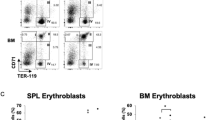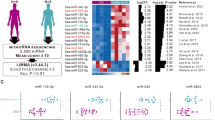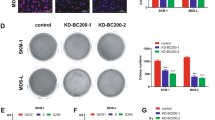Abstract
Acute erythroid leukemia (AEL) is characterized by lower incidence, poorer prognosis and worse survival than other types of leukemia and results from collaboration of malignant proliferation and erythroid differentiation blockage. The expression, function and therapeutic significance of noncoding RNAs in AEL have not been well studied. Here, we show that one miRNA cluster, including miR-23a, -27a and -24, is dramatically downregulated in AEL patients. Restoration of miR-23a, -27a and -24 expression induces apoptosis and erythropoiesis, inhibits adverse growth and partly relieves the leukemic symptoms of AEL patients. At the whole-genome scale, we identify that miR-23a, -27a and -24 synergistically target multiple members of the oncogenic gp130-JAK1-Stat3 pathway, and thus reinforce their inhibition on the cascade to regulate cell proliferation and apoptosis. Importantly, Ruxolitinib, a JAK1 inhibitor, could rescue the phenotypic changes induced by miR-23a, -27a and -24 inhibitors. Furthermore, miR-23a cluster-mediated-inactivation of the JAK1-Stat3 pathway promotes the expression and activity of GATA1 via inhibiting PU.1, thereby improving erythroid differentiation. Collectively, we reveal an important regulatory circuit comprising GATA1, the miR-23a cluster and gp130-JAK1-Stat3 pathway, that synergistically facilitates apoptosis and erythropoiesis and restrains adverse proliferation, indicating the therapeutic significance of miR-23a, -27a and -24 for AEL treatment.
This is a preview of subscription content, access via your institution
Access options
Subscribe to this journal
Receive 50 print issues and online access
$259.00 per year
only $5.18 per issue
Buy this article
- Purchase on Springer Link
- Instant access to full article PDF
Prices may be subject to local taxes which are calculated during checkout








Similar content being viewed by others
References
Goldberg SL, Noel P, Klumpp TR, Dewald GW . The erythroid leukemias: a comparative study of erythroleukemia (FAB M6) and Di Guglielmo disease. Am J Clin Oncol 1998; 21: 42–47.
Wells AW, Bown N, Reid MM, Hamilton PJ, Jackson GH, Taylor PR . Erythroleukaemia in the north of England: a population based study. J Clin Pathol 2001; 54: 608–612.
Bennett JM, Catovsky D, Daniel MT, Flandrin G, Galton DA, Gralnick HR et al. Proposed revised criteria for the classification of acute myeloid leukemia. A report of the French-American-British Cooperative Group. Ann Intern Med 1985; 103: 620–625.
Hasserjian RP, Zuo Z, Garcia C, Tang G, Kasyan A, Luthra R et al. Acute erythroid leukemia: a reassessment using criteria refined in the 2008 WHO classification. Blood 2010; 115: 1985–1992.
Santos FP, Faderl S, Garcia-Manero G, Koller C, Beran M, O'Brien S et al. Adult acute erythroleukemia: an analysis of 91 patients treated at a single institution. Leukemia 2009; 23: 2275–2280.
Cui JW, Li YJ, Sarkar A, Brown J, Tan YH, Premyslova M et al. Retroviral insertional activation of the Fli-3 locus in erythroleukemias encoding a cluster of microRNAs that convert Epo-induced differentiation to proliferation. Blood 2007; 110: 2631–2640.
Blum S, Angelillo-Scherrer A . Block of red blood cell maturation in acute erythroid leukemia. Blood 2012; 120: 1974.
Fan C, Xiong Y, Zhu N, Lu Y, Zhang J, Wang S et al. Random small interfering RNA library screen identifies siRNAs that induce human erythroleukemia cell differentiation. Leuk Lymphoma 2011; 52: 502–514.
Ren JG, Seth P, Everett P, Clish CB, Sukhatme VP . Induction of erythroid differentiation in human erythroleukemia cells by depletion of malic enzyme 2. PLoS One 2010; 5: pii: e12520.
Felli N, Fontana L, Pelosi E, Botta R, Bonci D, Facchiano F et al. MicroRNAs 221 and 222 inhibit normal erythropoiesis and erythroleukemic cell growth via kit receptor down-modulation. Proc Natl Acad Sci USA 2005; 102: 18081–18086.
Gao XN, Lin J, Gao L, Li YH, Wang LL, Yu L . MicroRNA-193b regulates c-Kit proto-oncogene and represses cell proliferation in acute myeloid leukemia. Leuk Res 2011; 35: 1226–1232.
Kayali S, Giraud G, Morle F, Guyot B . Spi-1, Fli-1 and Fli-3 (miR-17-92) oncogenes contribute to a single oncogenic network controlling cell proliferation in friend erythroleukemia. PLoS One 2012; 7: e46799.
McCubrey JA, Steelman LS, Bertrand FE, Davis NM, Abrams SL, Montalto G et al. Multifaceted roles of GSK-3 and Wnt/beta-catenin in hematopoiesis and leukemogenesis: opportunities for therapeutic intervention. Leukemia 2014; 28: 15–33.
Eaves CJ, Humphries RK . Acute myeloid leukemia and the Wnt pathway. N Engl J Med 2010; 362: 2326–2327.
Neri LM, Cani A, Martelli AM, Simioni C, Junghanss C, Tabellini G et al. Targeting the PI3K/Akt/mTOR signaling pathway in B-precursor acute lymphoblastic leukemia and its therapeutic potential. Leukemia 2014; 28: 739–748.
Vainchenker W, Constantinescu SN . JAK/STAT signaling in hematological malignancies. Oncogene 2013; 32: 2601–2613.
Steelman LS, Abrams SL, Whelan J, Bertrand FE, Ludwig DE, Basecke J et al. Contributions of the Raf/MEK/ERK, PI3K/PTEN/Akt/mTOR and Jak/STAT pathways to leukemia. Leukemia 2008; 22: 686–707.
Steelman LS, Franklin RA, Abrams SL, Chappell W, Kempf CR, Basecke J et al. Roles of the Ras/Raf/MEK/ERK pathway in leukemia therapy. Leukemia 2011; 25: 1080–1094.
Lunghi P, Tabilio A, Lo-Coco F, Pelicci PG, Bonati A . Arsenic trioxide (ATO) and MEK1 inhibition synergize to induce apoptosis in acute promyelocytic leukemia cells. Leukemia 2005; 19: 234–244.
Monaghan KA, Khong T, Burns CJ, Spencer A . The novel JAK inhibitor CYT387 suppresses multiple signalling pathways, prevents proliferation and induces apoptosis in phenotypically diverse myeloma cells. Leukemia 2011; 25: 1891–1899.
Ma Y, Yao N, Liu G, Dong L, Liu Y, Zhang M et al. Functional screen reveals essential roles of miR-27a/24 in differentiation of embryonic stem cells. EMBO J 2015; 34: 361–378.
Wang F, Zhu Y, Guo L, Dong L, Liu H, Yin H et al. A regulatory circuit comprising GATA1/2 switch and microRNA-27a/24 promotes erythropoiesis. Nucleic Acids Res 2014; 42: 442–457.
Zhu Y, Wang D, Wang F, Li T, Dong L, Liu H et al. A comprehensive analysis of GATA-1-regulated miRNAs reveals miR-23a to be a positive modulator of erythropoiesis. Nucleic Acids Res 2013; 41: 4129–4143.
Ma Y, Wang B, Jiang F, Wang D, Liu H, Yan Y et al. A feedback loop consisting of microRNA 23a/27a and the beta-like globin suppressors KLF3 and SP1 regulates globin gene expression. Mol Cell Biol 2013; 33: 3994–4007.
Zhou T, Georgeon S, Moser R, Moore DJ, Caflisch A, Hantschel O . Specificity and mechanism-of-action of the JAK2 tyrosine kinase inhibitors ruxolitinib and SAR302503 (TG101348). Leukemia 2014; 28: 404–407.
Teramo A, Gattazzo C, Passeri F, Lico A, Tasca G, Cabrelle A et al. Intrinsic and extrinsic mechanisms contribute to maintain the JAK/STAT pathway aberrantly activated in T-type large granular lymphocyte leukemia. Blood 2013; 121: S3841.
Hegde S, Ni S, He S, Yoon D, Feng GS, Watowich SS et al. Stat3 promotes the development of erythroleukemia by inducing Pu.1 expression and inhibiting erythroid differentiation. Oncogene 2009; 28: 3349–3359.
Rhodes J, Hagen A, Hsu K, Deng M, Liu TX, Look AT et al. Interplay of pu.1 and gata1 determines myelo-erythroid progenitor cell fate in zebrafish. Dev Cell 2005; 8: 97–108.
Zhang P, Zhang X, Iwama A, Yu C, Smith KA, Mueller BU et al. PU.1 inhibits GATA-1 function and erythroid differentiation by blocking GATA-1 DNA binding. Blood 2000; 96: 2641–2648.
Vannucchi AM, Lasho TL, Guglielmelli P, Biamonte F, Pardanani A, Pereira A et al. Mutations and prognosis in primary myelofibrosis. Leukemia 2013; 27: 1861–1869.
Grossmann V, Bacher U, Haferlach C, Schnittger S, Potzinger F, Weissmann S et al. Acute erythroid leukemia (AEL) can be separated into distinct prognostic subsets based on cytogenetic and molecular genetic characteristics. Leukemia 2013; 27: 1940–1943.
Lo MC, Peterson LF, Yan M, Cong X, Hickman JH, Dekelver RC et al. JAK inhibitors suppress t(8;21) fusion protein-induced leukemia. Leukemia 2013; 27: 2272–2279.
Suzuki M, Kobayashi-Osaki M, Tsutsumi S, Pan X, Ohmori S, Takai J et al. GATA factor switching from GATA2 to GATA1 contributes to erythroid differentiation. Genes Cells 2013; 18: 921–933.
Fazi F, Rosa A, Fatica A, Gelmetti V, De Marchis ML, Nervi C et al. A minicircuitry comprised of microRNA-223 and transcription factors NFI-A and C/EBPalpha regulates human granulopoiesis. Cell 2005; 123: 819–831.
Jiang X, Huang H, Li Z, Li Y, Wang X, Gurbuxani S et al. Blockade of miR-150 maturation by MLL-fusion/MYC/LIN-28 is required for MLL-associated leukemia. Cancer Cell 2012; 22: 524–535.
Mascarenhas J, Hoffman R . Ruxolitinib: the first FDA approved therapy for the treatment of myelofibrosis. Clin Cancer Res 2012; 18: 3008–3014.
Maude SL, Dolai S, Delgado-Martin C, Vincent T, Robbins A, Selvanathan A et al. Efficacy of JAK/STAT pathway inhibition in murine xenograft models of early T-cell precursor (ETP) acute lymphoblastic leukemia. Blood 2015; 125: 1759–1767.
Gallipoli P, Cook A, Rhodes S, Hopcroft L, Wheadon H, Whetton AD et al. JAK2/STAT5 inhibition by nilotinib with ruxolitinib contributes to the elimination of CML CD34+ cells in vitro and in vivo. Blood 2014; 124: 1492–1501.
Pevny L, Simon MC, Robertson E, Klein WH, Tsai SF, D'Agati V et al. Erythroid differentiation in chimaeric mice blocked by a targeted mutation in the gene for transcription factor GATA-1. Nature 1991; 349: 257–260.
Mancini E, Sanjuan-Pla A, Luciani L, Moore S, Grover A, Zay A et al. FOG-1 and GATA-1 act sequentially to specify definitive megakaryocytic and erythroid progenitors. EMBO J 2012; 31: 351–365.
de Thonel A, Vandekerckhove J, Lanneau D, Selvakumar S, Courtois G, Hazoume A et al. HSP27 controls GATA-1 protein level during erythroid cell differentiation. Blood 2010; 116: 85–96.
Kadri Z, Shimizu R, Ohneda O, Maouche-Chretien L, Gisselbrecht S, Yamamoto M et al. Direct binding of pRb/E2F-2 to GATA-1 regulates maturation and terminal cell division during erythropoiesis. PLoS Biol 2009; 7: e1000123.
Su R, Lin H, Zhang X, Yin X, Ning H, Liu B et al. MiR-181 family: regulators of myeloid differentiation and acute myeloid leukemia as well as potential therapeutic targets. Oncogene 2015; 34: 3226–3239.
Munn JS, Schroeter EH, Saxena MT, Griesemer A, Tian X, Pan DJ et al. A ligand-induced extracellular cleavage regulates gamma-secretase-like proteolytic activation of Notch1. Mol Cell 2000; 5: 197–206.
Acknowledgements
We thank for Dr Jianjun Chen for his assistance and constructive suggestions. This work was supported by the National Key Basic Research Program of China (2011CBA01100 to JY); National Natural Science Foundation of China (81530007 to JY, 31040021 to JY, 31171311 to FW, 31471227 to FW and 30970616 to FW).
Author information
Authors and Affiliations
Corresponding authors
Ethics declarations
Competing interests
The authors declare no conflict of interest.
Additional information
Supplementary Information accompanies this paper on the Oncogene website
Supplementary information
Rights and permissions
About this article
Cite this article
Su, R., Dong, L., Zou, D. et al. microRNA-23a, -27a and -24 synergistically regulate JAK1/Stat3 cascade and serve as novel therapeutic targets in human acute erythroid leukemia. Oncogene 35, 6001–6014 (2016). https://doi.org/10.1038/onc.2016.127
Received:
Revised:
Accepted:
Published:
Issue Date:
DOI: https://doi.org/10.1038/onc.2016.127
This article is cited by
-
Clinical and biological aspects of myeloid leukemia in Down syndrome
Leukemia (2021)
-
Hippo/MST blocks breast cancer by downregulating WBP2 oncogene expression via miRNA processor Dicer
Cell Death & Disease (2020)
-
A step-by-step microRNA guide to cancer development and metastasis
Cellular Oncology (2017)
-
Targeted inhibition of STAT/TET1 axis as a therapeutic strategy for acute myeloid leukemia
Nature Communications (2017)



